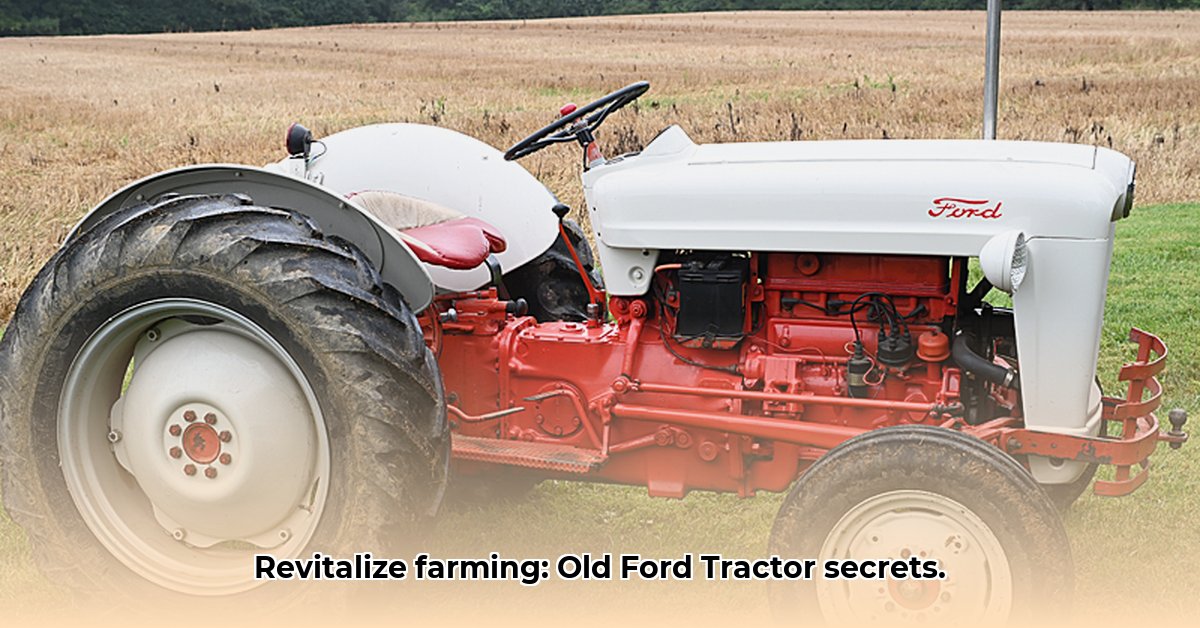
Ford Tractors and Sustainable Farming: A Historical Perspective
The iconic blue Ford tractor, a symbol of agricultural progress for generations, is experiencing a resurgence. But can these vintage machines contribute to modern sustainable farming practices? This article explores the complex relationship between Ford tractors and sustainable agriculture, examining their historical influence, weighing their present-day advantages and disadvantages, and offering practical guidance for farmers considering their use. The question isn't simply whether an old Ford can till the soil, but whether it can do so in a way that benefits both the farmer and the planet. For more information on Ford tractor history, check out this useful resource.
Did you know that the Ford 9N, introduced in 1939, revolutionized farming by making advanced machinery accessible to a much wider range of farmers? This democratization of technology significantly increased food production globally. However, the environmental implications of this agricultural revolution are a crucial element of the conversation today. This increased food production came at a cost that modern sustainable practices are working diligently to address.
Assessing the Suitability of Old Ford Tractors for Sustainable Farming
Let's delve into the specifics, analyzing the pros and cons of using vintage Ford tractors in a modern, sustainable farming context.
Advantages:
Simplicity and Durability: Older Ford tractors are generally simpler machines with fewer electronic components, resulting in less frequent breakdowns and easier maintenance. Their robust construction ensures longevity, minimizing the need for frequent replacements – a considerable benefit for sustainability. "These tractors were built to last," says Dr. Emily Carter, Agricultural Engineering Professor at Purdue University. "Their basic mechanics often prove more resilient to the harsh conditions of agricultural work."
Ease of Repair and Maintenance: The straightforward design allows for simpler repairs, often manageable with readily available tools and basic mechanical skills. This reduces reliance on expensive specialist repairs and consequently minimizes waste associated with discarding malfunctioning parts. This self-sufficiency fosters a more sustainable and cost-effective farming model.
Potential for Lower Carbon Footprint (with caveats): While older engines are less fuel-efficient than modern counterparts and produce higher emissions, the possibility of using alternative fuels like biodiesel could potentially lower the overall carbon footprint compared to newer models. This approach, however, hinges on access to sustainable fuel sources and efficient conversion systems. “The potential for lower emissions is largely dependent on the fuel used; the tractor itself is just one piece of the equation,” notes Dr. David Lee, Head of Sustainable Agriculture Research at the University of California, Davis.
Affordability: The lower purchase price of used Ford tractors makes them an attractive option for smaller farms or those with limited financial resources. This accessibility can be a crucial step in promoting sustainable agricultural practices among a wider spectrum of farmers.
Disadvantages:
Parts Availability: Sourcing replacement parts for older models can be exceptionally challenging. The dwindling supply chain and the limited availability of original equipment parts often necessitate creative solutions or compromises on functionality.
Lower Fuel Efficiency: Older engines are known for their poor fuel efficiency, consuming more fuel per unit of work than modern tractors. This considerable drawback negates some of the environmentally friendly aspects of using alternative fuels.
Higher Emissions: Vintage engines typically produce significantly more greenhouse gas emissions than modern tractors meeting current environmental standards. The environmental consequences of these emissions must be carefully considered within any sustainable farming model.
Safety Concerns: Many older Ford tractors lack the safety features of modern models, increasing the risk of accidents. This increased risk presents a compelling argument against adopting this technology in modern farming practices.
Sustainable Farming: A Holistic Approach
It's paramount to remember that sustainable farming is a multifaceted practice extending far beyond the choice of tractor. While a vintage Ford might have a role in specific contexts, it is vital to consider the overall farm operation and environmental impact. Successful sustainable farming necessitates a holistic approach integrating various elements such as crop rotation, soil health management, water conservation, and integrated pest management.
Practical Steps for Integrating Vintage Ford Tractors (if appropriate)
Comprehensive Mechanical Inspection: Before acquiring a used tractor, ensure a thorough inspection by a qualified mechanic to identify potential problems and assess repair needs.
Parts Availability Assessment: Research the availability of replacement parts, considering alternative sourcing strategies like online communities, salvage yards, or specialized dealers.
Sustainable Fuel Strategy: Develop a plan for using alternative fuels, such as biodiesel, to mitigate the environmental impact of fuel consumption.
Proactive Maintenance Strategy: Implement a rigorous maintenance schedule to ensure the tractor's longevity and to minimize its environmental impact.
Comparative Analysis: Thoroughly compare the performance, costs, and environmental impact of a vintage Ford tractor with newer, more efficient models before making a final decision.
Conclusion: Balancing Tradition and Innovation in Sustainable Farming
Vintage Ford tractors represent a pivotal chapter in agricultural history. While they may find a niche within certain sustainable farming models, their suitability must be carefully evaluated in the context of current technological advancements and environmental requirements. A successful path towards sustainable agriculture requires a strategic balance between respecting the legacy of traditional methods and embracing innovation to secure a greener future for farming.